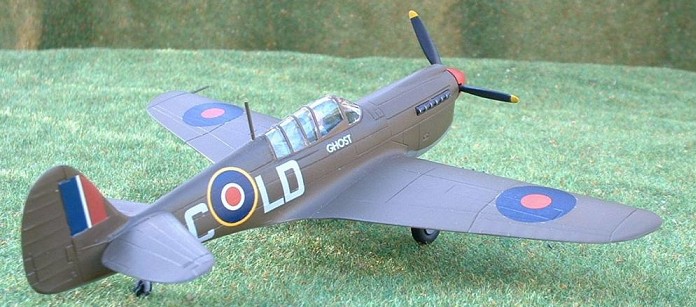
Matchbox 1/72 P-40N Kittyhawk IV
| KIT: | Matchbox 1/72 P-40N Kittyhawk IV |
| KIT #: | PK 31 |
| PRICE: | $Currently Out Of Production |
| DECALS: | Two options |
| REVIEWER: | Pat Cauthery |
| NOTES: |

| HISTORY |
According to Matchbox, “The Curtess P40N originated as a lightened version of earlier marks and was powered by an Allison engine. The first 400 aircraft of this type were built with 4 * 50 cal wing mounted guns but on later models the armaments were increased to 6 * 50cal guns. On later models also modifications were made to the cockpit to improve the rear view, approx 3240 of this version were built. A large number of these aircraft were supplied to Commonwealth countries and to the Soviet Union, but many were used by American units throughout the Far East where they served until the end of the war.”
| THE KIT |
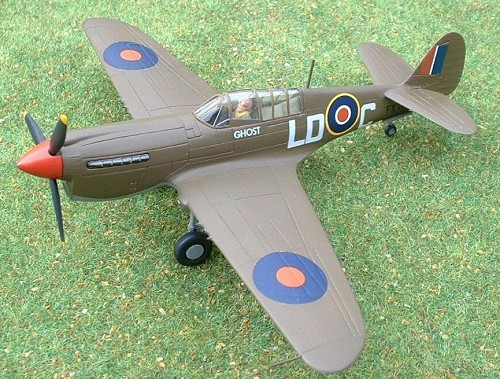 A vision in
two-tone blue. As you would expect a simple kit on two small sprues plus
clear parts. As well as the expected heavily engraved control surfaces,
this one is curiously covered in a grid pattern of raised lines on wings
and fuselage.
A vision in
two-tone blue. As you would expect a simple kit on two small sprues plus
clear parts. As well as the expected heavily engraved control surfaces,
this one is curiously covered in a grid pattern of raised lines on wings
and fuselage.
If you were wanting to build an accurate scale model of the P-40 I guess you would not choose to start from here. I have seen this kit described as being too short in length although with correct wingspan and also damningly described as “not for the serious modeller”.
I thought I would have a go at this because i) I had one, ii) I wanted to practice engraving panel lines on something and iii) I thought Matchbox kits were the business as a kid and this was one that I never built 25 odd years ago. This kit brings back memories of one day builds, sagging undercarriage, frosted canopies and tins of enamel spilt on new carpets.
More stirring artwork on the box comes in the guise of the usual Roy Huxley painting, this time showing an RAF Kittyhawk at the moment of releasing a bomb onto the heads of the retreating Germans. I am sure I had a couple of jigsaws as a child that were based on various Matchbox boxart – does this ring any bells with anyone?
| CONSTRUCTION |
I started by sanding off the grid pattern and then selectively engraving some of the panel lines myself. I copied a technique that I picked up from this site using Dymo tape and a pin. I found a pin it had to be as a needle was too stiff and skipped about on the plastic, but the pin had just the right amount of give in it. After much cursing and filling of rogue scratches I was broadly happy with my “improvement”.
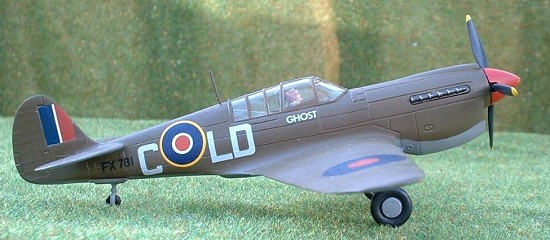 The cockpit
consists of a rear bulkhead with a headrest and a wide bench seat that
fills the width of the fuselage. A control stick is provided that is glued
onto the front of the seat. A pilot figure is provided and is probably a
must to fill the cockpit and divert attention from his surroundings. I
painted the interior Gunze US Interior Green.
The cockpit
consists of a rear bulkhead with a headrest and a wide bench seat that
fills the width of the fuselage. A control stick is provided that is glued
onto the front of the seat. A pilot figure is provided and is probably a
must to fill the cockpit and divert attention from his surroundings. I
painted the interior Gunze US Interior Green.
The “cockpit” fits between the two fuselage halves and I found I needed to shave a bit off the sides to get it to sit in its intended position. Plus you need to sand down the top of the “seat” to stop it interfering with the canopy. Fit of the wings to the fuselage left something to be desired – you are faced with a choice of a large gap at either the top or bottom of the wing root, or both if the correct dihedral is desired. Plenty of filler was therefore needed in the wing roots. Filler was also needed for the fairing at the front of the main undercarriage bay. Matchbox’s instructions have part of this being fitted at the end of the construction process and consequently I left it off until after I had painted the underside - this was a mistake.
The aerial mast is mounted on a square block of plastic that fits in a hole on top of the fuselage. It’s as terrible as it sounds so I chopped off the mast and used the square and filler to block off the hole. A new mast was added from the spares box.
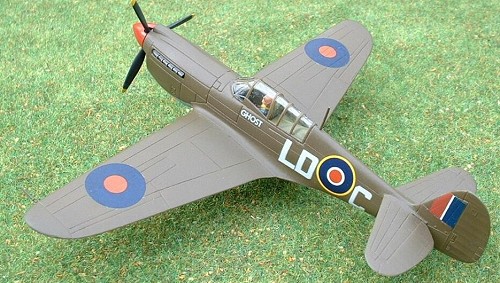 Fit of the
tailplanes was quite good!
Fit of the
tailplanes was quite good!
The wing mounted mg’s are a little crude and I managed to snap off some of the tips in the building process. I replaced these with tiny pieces of stretched sprue. These were also knocked off countless times.
The canopy also had me scratching my head until I realised that there is a glitch in Matchbox’s framing. There appears to be a superfluous frame in the middle of the port front quarter window. All pictures I could find (including the box art) show this window as one piece. The frame is too distinct to be a moulding flaw and I can think of no reason why the Tomahawk should have an asymmetric canopy so I masked around the rogue frame.
| COLORS & MARKINGS |
Decals for two aircraft are provided both Olive Drab over Neutral Gray. I chose to build an aircraft from 250 sqd RAF based in Italy 1944, named “Ghost”. The other option is for a USAF aircraft based in India in 1944 with a large skull motif on the front.
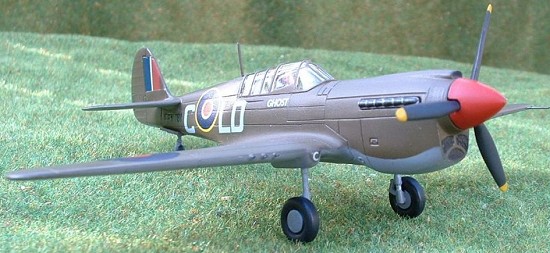 The kit was
painted using Gunze Sangyo OD/NG with Gunze RLM 23 for the red spinner. I
realise that RLM 23 is not renowned for its use by the RAF but the shade of
red seemed about right i.e. not too bright. The bright blue plastic also
had an annoying habit of showing through on the wing and tailplane trailing
edges where I had handled the model.
The kit was
painted using Gunze Sangyo OD/NG with Gunze RLM 23 for the red spinner. I
realise that RLM 23 is not renowned for its use by the RAF but the shade of
red seemed about right i.e. not too bright. The bright blue plastic also
had an annoying habit of showing through on the wing and tailplane trailing
edges where I had handled the model.
I botched the first attempt at decal placement and made an emergency call on the MM forum that was kindly answered by Grant in West Oz who sent me some replacements. Roundels were from Fantasy Printshop, fin flash from Xtradecal and the squadron codes and other lettering a combination of my kit and Grant’s replacement decals.
In fact I later found a picture of this aircraft that showed I had still messed up the decals as the serial number in fact is partially obscured by the code letters on the real thing.
| CONCLUSIONS |
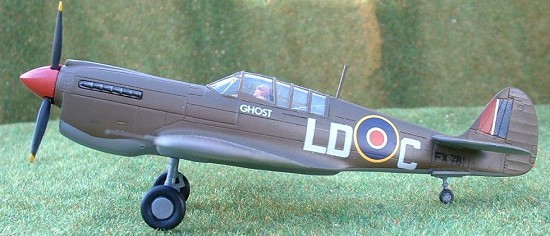 I guess this
kit would come well down the list of those wanting to build a Kittyhawk. I
imagine you would look at the Hasegawa or Academy kits in the first
instance. With all the spurious raised detail and clumsy fit of some of the
parts you are talking about a kit that is probably well matched to its
target audience i.e. small boys. A plus point is the unusual decal choice
that was typical of Matchbox, who daringly decided not to provide an option
with a sharkmouth. But actually I enjoyed making this simple model which I
suppose is what it is all about.
I guess this
kit would come well down the list of those wanting to build a Kittyhawk. I
imagine you would look at the Hasegawa or Academy kits in the first
instance. With all the spurious raised detail and clumsy fit of some of the
parts you are talking about a kit that is probably well matched to its
target audience i.e. small boys. A plus point is the unusual decal choice
that was typical of Matchbox, who daringly decided not to provide an option
with a sharkmouth. But actually I enjoyed making this simple model which I
suppose is what it is all about.
November 2005
| REFERENCES |
Pictorial Guide to the Mediterranean Air War (Volume II) – pub. Ian Allen
If you would like your product reviewed fairly and quickly , please contact me or see other details in the Note to Contributors.